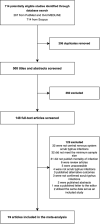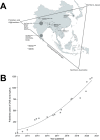Neurological manifestations of scrub typhus infection: A systematic review and meta-analysis of clinical features and case fatality
- PMID: 36441812
- PMCID: PMC9731453
- DOI: 10.1371/journal.pntd.0010952
Neurological manifestations of scrub typhus infection: A systematic review and meta-analysis of clinical features and case fatality
Abstract
Background: Scrub typhus has become a leading cause of central nervous system (CNS) infection in endemic regions. As a treatable condition, prompt recognition is vital. However, few studies have focused on describing the symptomology and outcomes of neurological scrub typhus infection. We conducted a systematic review and meta-analysis to report the clinical features and case fatality ratio (CFR) in patients with CNS scrub typhus infection.
Methods: A search and analysis plan was published in PROSPERO [ID 328732]. A systematic search of PubMed and Scopus was performed and studies describing patients with CNS manifestations of proven scrub typhus infection were included. The outcomes studied were weighted pooled prevalence (WPP) of clinical features during illness and weighted CFR.
Results: Nineteen studies with 1,221 (656 adults and 565 paediatric) patients were included. The most common clinical features in CNS scrub typhus were those consistent with non-specific acute encephalitis syndromes (AES), such as fever (WPP 100.0% [99.5%-100.0%, I2 = 47.8%]), altered sensorium (67.4% [54.9-78.8%, I2 = 93.3%]), headache (65.0% [51.5-77.6%, I2 = 95.1%]) and neck stiffness 56.6% (29.4-80.4%, I2 = 96.3%). Classical features of scrub typhus were infrequently identified; an eschar was found in only 20.8% (9.8%-34.3%, I2 = 95.4%) and lymphadenopathy in 24.1% (95% CI 11.8% - 38.9%, I2 = 87.8%). The pooled CFR (95% CI) was 3.6% (1.5%- 6.4%, I2 = 67.3%). Paediatric cohorts had a CFR of 6.1% (1.9-12.1%, I2 = 77%) whilst adult cohorts reported 2.6% (0.7-5.3%, I2 = 43%).
Conclusion: Our meta-analyses illustrate that 3.6% of patients with CNS manifestations of scrub typhus die. Clinicians should have a high index of suspicion for scrub typhus in patients presenting with AES in endemic regions and consider starting empiric treatment whilst awaiting results of investigations, even in the absence of classical signs such as an eschar or lymphadenopathy.
Copyright: © 2022 Alam et al. This is an open access article distributed under the terms of the Creative Commons Attribution License, which permits unrestricted use, distribution, and reproduction in any medium, provided the original author and source are credited.
Conflict of interest statement
The authors have declared that no competing interests exist.
Figures




Similar articles
-
Neurological Manifestations of Scrub Typhus.Curr Neurol Neurosci Rep. 2022 Aug;22(8):491-498. doi: 10.1007/s11910-022-01215-5. Epub 2022 Jun 21. Curr Neurol Neurosci Rep. 2022. PMID: 35727462 Review.
-
Scrub typhus in rural Rajasthan and a review of other Indian studies.Paediatr Int Child Health. 2016 May;36(2):148-53. doi: 10.1179/2046905515Y.0000000004. Paediatr Int Child Health. 2016. PMID: 25704650
-
Clinical profile and improving mortality trend of scrub typhus in South India.Int J Infect Dis. 2014 Jun;23:39-43. doi: 10.1016/j.ijid.2014.02.009. Epub 2014 Mar 21. Int J Infect Dis. 2014. PMID: 24661931
-
Prevalence of malaria and scrub typhus co-infection in febrile patients: a systematic review and meta-analysis.Parasit Vectors. 2021 Sep 14;14(1):471. doi: 10.1186/s13071-021-04969-y. Parasit Vectors. 2021. PMID: 34521454 Free PMC article.
-
Prevalence, Clinico-Laboratory Features and Outcomes of Paediatric Scrub Typhus Cases in a Tertiary Care Centre in Eastern India: A prospective observational study.Sultan Qaboos Univ Med J. 2024 Aug;24(3):375-382. doi: 10.18295/squmj.6.2024.032. Epub 2024 Aug 29. Sultan Qaboos Univ Med J. 2024. PMID: 39234326 Free PMC article.
Cited by
-
Scrub typhus, a salient threat: Needs attention.PLoS Negl Trop Dis. 2023 Jun 29;17(6):e0011427. doi: 10.1371/journal.pntd.0011427. eCollection 2023 Jun. PLoS Negl Trop Dis. 2023. PMID: 37384603 Free PMC article.
-
Pneumonia due to scrub typhus infection: a case report.BMC Pulm Med. 2025 Jul 12;25(1):340. doi: 10.1186/s12890-025-03827-2. BMC Pulm Med. 2025. PMID: 40652235 Free PMC article.
-
Case Report: Encephalitis with Initial Manifestation of Orientia Tsutsugamushi Infection Detected by Metagenomic Next-Generation Sequencing.Infect Drug Resist. 2024 Feb 26;17:749-760. doi: 10.2147/IDR.S450693. eCollection 2024. Infect Drug Resist. 2024. PMID: 38433784 Free PMC article.
-
Trends in Clinico-radiological and Laboratory Characteristics of All-Cause Meningoencephalitis in Western Rajasthan.Ann Indian Acad Neurol. 2024 Nov 1;27(6):638-646. doi: 10.4103/aian.aian_352_24. Epub 2024 Nov 25. Ann Indian Acad Neurol. 2024. PMID: 39585313 Free PMC article.
-
Molecular detection of Orientia tsutsugamushi in ectoparasites & their small mammal hosts captured from scrub typhus endemic areas in Madurai district, India.Indian J Med Res. 2024 Feb 1;159(2):180-192. doi: 10.4103/ijmr.ijmr_3530_21. Epub 2024 Apr 4. Indian J Med Res. 2024. PMID: 38494626 Free PMC article.
References
-
- Luce-Fedrow A, Lehman ML, Kelly DJ, Mullins K, Maina AN, Stewart RL, et al.. A Review of Scrub Typhus (Orientia tsutsugamushi and Related Organisms): Then, Now, and Tomorrow. Trop Med Infect Dis. 2018;3(1). Epub 2018/10/03. doi: 10.3390/tropicalmed3010008 ; PubMed Central PMCID: PMC6136631. - DOI - PMC - PubMed
Publication types
MeSH terms
Grants and funding
LinkOut - more resources
Full Text Sources
Research Materials

